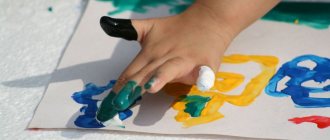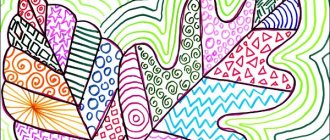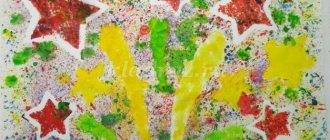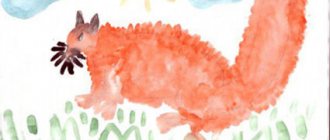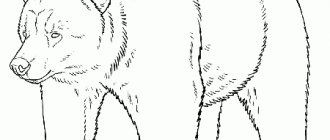Progress of the lesson.
Educator: Guys, listen to the nursery rhyme and you will find out who came to visit us.
Educator: That's right, bunny!
There is a knock on the door.
Educator: I wonder who else came to us?
He brings in the fox: the teacher puts a bi-ba-bo doll on his hand and says on her behalf: “Hello! Whoa, who do I see (a hare, I want to play hide and seek with you. I will turn my back, and you hide."
Educator: Guys, let's help the bunny, otherwise the fox will catch him and eat him! Shall we help the bunny?
Educator: What can we do to save the bunny?
Children's answers. The teacher praises and selects the most successful and inventive answers.
Educator: It’s winter outside, everything is covered with white snow . And the little hares in their gray fur coat stand out against the white snow .
Educator: What color is the fur of bunnies in winter?
Educator: Correct. A white fur coat is needed so that the hare is not visible in the snow . What other kind of fur do rabbits have?
Children: She is fluffy and soft.
Educator: Well done! In order for our bunnies to have the same fur, you need to pick up a little white gouache with a dry, hard brush, and, holding the brush vertically, make pokes on top inside the outline.
drawing methods .
Independent activity of children.
At the end of the lesson, the results are summed up .
Educator: Well done! Look what beautiful white and fluffy bunnies you have made! Well, little fox, you can look for bunnies!
Fox (addressing the children)
: “Now I’ll quickly find the hares.
(Looks at the children's work)
. Where are they? Well, again I couldn’t catch the rabbits. "
Educator: “Well done, guys! They helped the bunnies well.”
Photo report on a drawing lesson with children aged 5–6 years on the topic “Hare in the Snow” Our bunnies are fashionistas, They have changed their frock coats: Nowadays the hares are white, Even though they were grey. In autumn it is easier for gray people to live among gray nature, and in winter it is calmer.
Abstract of an integrated GCD on the topic “Wild animals. Hare" (early age) Purpose: Introducing children to wild animals. Objectives: To introduce children to wild animals; Teach children to understand the question and answer it;
Summary of educational activities for children of the second junior group “Let's help the squirrel. Wild animals" Problems. To consolidate children’s ideas about autumn, its characteristic features, and autumn natural phenomena. Reinforce the concept of “wild animals”.
Abstract of the GCD in the second junior group “Wild animals and their young” Purpose: to summarize children’s ideas about wild animals and their young. Objectives: Educational: Consolidating ideas about features.
Summary of educational activities “Wild and domestic animals.” For the second younger group, a summary of educational activities with preschool children: in the field of “Cognitive development.” For the second younger group. By.
Abstract of an OD on drawing in the second junior group “Trees in the Snow” MBDOU Kindergarten No. 5 “Kalinka” p Enem Republic of Adygea Abstract of an OD on drawing in the 2nd junior group “Trees in the Snow” Higher education teacher.
Source
Notes on drawing in the second junior group “Hare in winter”
Yosypiv Ekaterina
Notes on drawing in the second junior group “Hare in winter”
Goal: To consolidate children’s knowledge and ideas about the change in color of a hare in winter , to continue to teach children to draw round objects .
• consolidate children's knowledge about the life of wild animals in winter;
• learn to draw round objects;
• Enrich children's vocabulary and develop the ability to describe an animal using adjectives: the fur coat is white, fluffy, warm, soft, the ears are long, the tail is short;
• develop thinking, creative imagination;
• develop fine motor skills of the hands.
• cultivate kindness and responsiveness;
• develop the ability to work with paint carefully;
Preliminary work: Examination of illustrations depicting a hare in winter .
chairs (according to the number of children)
;
Letter from the Hares;
Layout " Winter Forest "
;
Audio speaker with the musical game “The Fox and the Hares”
;
gouache white, black, color (according to the number of children)
;
tassels (according to the number of children)
;
sheets of blue paper, A-5 format (according to the number of children)
;
a glass of water (according to the number of children)
;
oilcloths (according to the number of children)
;
Summary of a drawing lesson in the second junior group “Wild animals. Hare in the snow"
Zhanara Disingazieva
Summary of a drawing lesson in the second junior group “Wild animals. Hare in the snow"
Topic of the lesson : “ Wild animals . Hare in the snow ."
Goal: to teach children to poke with a hard, semi-dry brush. Develop the ability to listen to a nursery rhyme and imitate the movements of a hare along the text. Give an idea of the life of a hare in the forest in winter.
Objectives: teach children to poke with a hard semi-dry brush inside the contour; convey in the drawing the features of the appearance of the hare. Strengthen technical drawing (hold the brush correctly)
.
Intensify the use of speech words denoting the characteristics of a rabbit’s fur (fluffy, soft, white, etc.)
. Improve dialogic speech. To develop children's aesthetic perception of winter nature. Promote the development of curiosity.
MAGAZINE Preschooler.RF
Notes on drawing for children of the 2nd junior group Topic: “Puppy”Target:
- Forming the ability of children to paint with a hard brush using the poking method, mastering the color palette (orange, brown).
Tasks:
Educational
- To develop children’s ability to paint with a hard brush using the poking method.
- Improve the ability to hold a brush correctly while working.
- Master the color palette (orange, brown)
- Strengthen the ability to draw with crumpled paper and select colors, complement small missing details using plasticine.
- Enrich children's vocabulary
Developmental
- Develop creative abilities and aesthetic perception.
Educational
- Cultivate a kind attitude towards pets.
- Cultivate activity and the desire to complete work to the end.
- Continue to encourage independence and creativity.
Correctional
- Develop fine motor skills of hands
Integration of educational areas:
- cognition
- communication
- artistic creativity
- socialization
- music
- health.
Materials:
Half a landscape sheet with a drawn outline of a puppy (for each child).
Brown, orange gouache, hard brush.
A small sheet of paper (palette) for each child to check the poke and the correctness of the chosen color, jars for brushes, plasticine lumps of different colors for the eyes (2 pcs.) and black for the nose (1 pc.), fabric napkins.
Two paper kennels (orange and brown) for the didactic game “Each dog has its own house .
Puppy caps for dynamic pause.
Demo material:
Outline of a puppy on a sheet of paper, film on a laptop with a picture of a puppy and a dog.
Preliminary work:
Looking at illustrations, postcards, paintings depicting dogs, playing with a toy dog, reading E. Charushin's stories about Tomka, watching the dog on a walk.
Progress of the lesson
Children enter the hall. Educator: - I’m very glad to see you, Hello! Draws children's attention to guests.
Children say greeting:
Hello hands - clap, clap! Hello legs - top, top! We need to say hello to each other! Hello dear guests!
We will draw!
The children turn to the teacher.
Voss: Guys, I’ll tell you a story about Grandma Arina (the teacher puts on an apron and scarf), who lived in a very beautiful, noisy yard and had many friendly, kind and funny pets.
The leader asks the children a question: “Do you like pets?”
Children: - Yes.
Then I invite you to take a walk through this wonderful yard and get to know my pets.
The voices of pets are heard. She lived with Ryaba the Hen, Rogatushka the Burenushka, a purring cat, a yoke horse and three cheerful little pigs.
Oh, guys, look, whose house is this? I wonder who lives in it?
Now I'll ring the bell. The sun calls (the monitor turns on), a dog and a puppy appear. A problematic situation is created: “How to help a puppy find friends ,” because he has no one to play with.
- Children, we need to help the puppy, draw friends. Shall we help? (Yes).
-I will teach you how to draw beautiful puppies using the poking method. Come to me. And the puppy will watch us how children can draw beautifully.
(Children approach the easel and stand in a semicircle.)
Educator: - You know how to paint with a soft brush, but today you will learn to paint with a hard brush. Try with your finger to see how hard the brush is... The brush bites...
Teacher (shows): - I put paint on a brush and paint with a poke: first I’ll paint the face along the contour, it’s round, and now in the middle. Then - the body, legs, tail. I’ll rinse the brush in water, dry it on a napkin and put it in a glass. And we will draw the grass under the paws in a way that is already familiar to you - with crumpled paper, what color? (green).
-Right. I put paint on a crumpled leaf and paint grass.
And I’ll make the nose and eyes out of plasticine, look. I take a small ball and press it to the muzzle with my finger, and now another one. Here are the eyes. And now the nose. Look how the dog turned out! Fluffy, soft, funny.
-Tell me, which brush will you use to paint the puppy’s fur? (hard).
-Where should you first draw the fur on the head or body?
Now sit down at the tables. Now we will do a little warm-up. Take a hard brush in your hands. Begin:
We hold the brush like this: (Hand on the elbow. Hold the brush above its metal part). It's difficult? No, it's nothing! The tassel poked and the heel clicked. (Move your hand along the text).
One poke, two pokes. And then, then, then (Circular movements of the hand). The brush runs around. Spun like a top.
After a poke comes a poke. (Children poke on the table with a dry brush).
- Well done, put some paint on a dry brush and get to work.
Independent work of children.
The teacher controls the drawing process and helps the children if necessary.
Physical education minute.
Friendly puppies run merrily, singing cheerfully in their ringing voices: “Woof - woof - woof!” And then the front legs raise,
And they happily wag their tails at each other. They ran away...... They played out (circling behind their tail). And everyone quickly gathered to see me (the teacher hugs the children) -2 times.
(Children perform movements in accordance with the text).
Voss: - Guys, we need to finish our work, and to do this, go to your tables. What haven't you done for the dogs yet?
Children answer: - Eyes and nose.
Voss: - That's right. Let's make eyes and a nose from plasticine. Take the small blue balls, these are the eyes, and place them on the puppy’s face and press with your finger.
-Well done! Ready!
-What else do we have left? Nose.
-Let's take a big black lump and make a nose for the dog.
Our puppies are ready.
-Now let’s draw the grass with crumpled paper.
Didactic game “Let’s put the puppy in the house .
Educator: - Children, take your work in your hands and come to me. In front of you are houses for puppies. We need to put brown puppies in a brown house, and orange (red) ones in an orange house. (Children place their puppies next to the houses of the corresponding color).
An analysis of children's work is carried out.
Educator: - Guys, what funny, wonderful puppies you have turned out to be: fluffy, cheerful! You tried, you worked carefully. Now Shustrik will have many, many friends!
A puppy is heard barking.
The boy turns on the laptop and a puppy appears, who is very happy and says to the children “thank you very much!”
Educator: - guys, let's remember what we did today? (Children's answers) What brush did you paint with? (hard). Well done! Today we tried, did a good deed for the puppy, and I’m giving you each a friend (the teacher gives out puppies).
Voss: - And now we need to return to the children's room. garden.
-Eyes close. The kids are smiling. The eyes open. They return to the kindergarten.
Summary of direct educational activities in artistic creativity Topic: “Puppy” 2nd junior group MBDOU No. 144 D/S “Sun” Educator high. sq. categories Kalacheva E.V.
| Next > |
On the topic: methodological developments, presentations and notes
This material will help the teacher introduce younger preschoolers to their native land. Children go on an exciting journey where they learn a lot about wild animals, their habits and their environment.
“Journey to the Enchanted Forest.” Lexical topic: Wild animals of our forests and their cubs. Correctional and educational goals. Expansion and activation of the dictionary on the topic “Wild Animals”. Images.
Activation of the dictionary on the topic.
A lesson on speech development in a preparatory speech therapy group on the topic “Wild Animals”.
Give an idea of the changes in the life of wild animals in the spring.
Summary of a lesson on the development of fine motor skills, topic: “Wild animals.”
Formation of cognitive interests in preschoolers in various types of activities, taking into account the regional component.
Source

